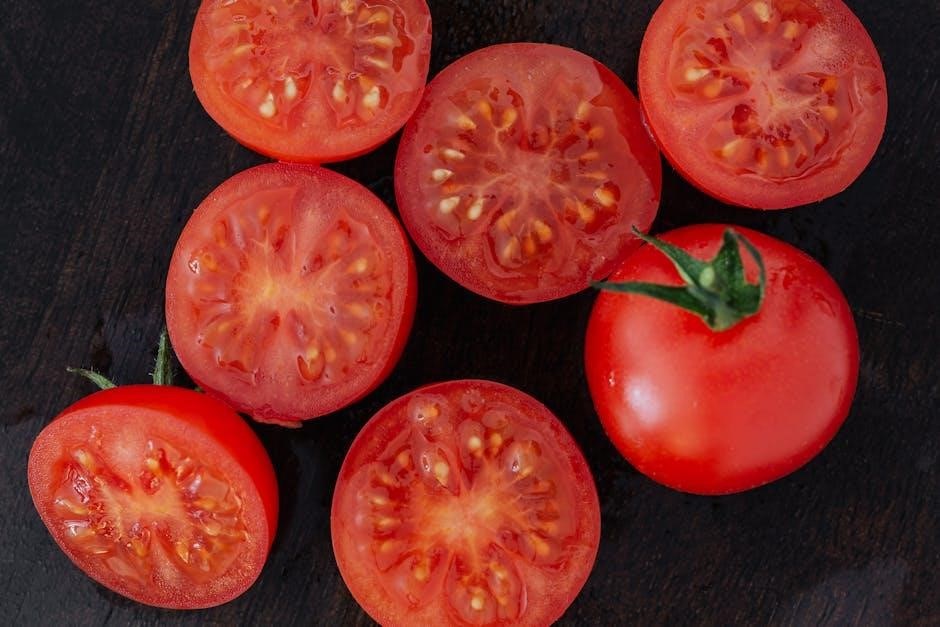
Clean bulking focuses on gaining muscle mass through a calorie-surplus diet with nutrient-dense foods. Meal plans serve as guides, not strict rules, to help structure your diet. Unlike dirty bulking, clean bulking emphasizes quality over quantity, reducing excess fat gain and promoting sustainable muscle growth.
1.1 What is Clean Bulking?
Clean bulking is a strategic approach to gaining muscle mass by consuming a calorie-surplus diet focused on nutrient-dense foods. It emphasizes lean protein, complex carbohydrates, and healthy fats to minimize fat gain while maximizing muscle growth. Unlike dirty bulking, which often leads to excess fat accumulation, clean bulking prioritizes quality and sustainability, ensuring a healthier and more aesthetic physique. This method requires careful meal planning and portion control to maintain a balance between muscle gain and fat storage.
1.2 Benefits of Clean Bulking Over Dirty Bulking
Clean bulking offers several advantages over dirty bulking, primarily through its focus on lean muscle growth. By prioritizing nutrient-dense foods, clean bulking minimizes excess fat gain, leading to a better muscle-to-fat ratio. It also supports long-term health by avoiding the negative impacts of poor dietary choices. Additionally, clean bulking promotes sustainability, as it avoids the cycle of extreme weight gain and loss associated with dirty bulking. This approach ensures a more aesthetic and functional physique while maintaining overall well-being.

Understanding Caloric Surplus for Clean Bulking
A caloric surplus is essential for clean bulking, providing energy for muscle growth. It involves consuming more calories than burned, focusing on nutrient-dense foods to avoid excess fat.
2.1 Importance of Calorie Surplus
A calorie surplus is crucial for muscle growth during clean bulking. It provides the energy needed to repair and build muscle tissue after intense workouts. Without sufficient surplus, your body lacks the necessary resources to synthesize new muscle proteins, hindering progress. A well-planned surplus ensures you gain lean muscle without excessive fat, making it a cornerstone of an effective clean bulking strategy.
2.2 How to Calculate Daily Caloric Needs
To calculate daily caloric needs for clean bulking, start with your maintenance calories, then add a surplus. For most, maintenance is 15-20 calories per pound of body weight. Add 250-500 calories to create a surplus. For example, a 180-pound male needs 2,700 to 3,600 calories daily. Adjust based on activity level and progress. Use online calculators or consult a nutritionist for accuracy. Regularly monitor weight and adjust calories to ensure lean muscle growth without excess fat gain.
Macronutrient Composition for Clean Bulking
Macronutrient balance is crucial for clean bulking. Prioritize protein for muscle repair, carbohydrates for energy, and healthy fats for hormone regulation. Aim for a balanced ratio to support growth while minimizing fat gain.
3.1 Role of Protein in Muscle Growth
Protein is essential for muscle growth, as it provides the building blocks for tissue repair and synthesis. Aim for 1 gram of protein per pound of body weight daily, sourced from lean meats, fish, eggs, and plant-based options. Consistent protein intake supports muscle recovery and growth, making it a cornerstone of any clean bulk meal plan. Incorporate protein-rich foods in every meal to maximize muscle gains while maintaining a balanced diet.
3.2 Carbohydrates for Energy and Recovery
Carbohydrates are vital for energy production and recovery during clean bulking. They fuel workouts and replenish glycogen stores, supporting muscle function and recovery. Focus on complex carbs like whole grains, fruits, and vegetables, which provide sustained energy. Include carb-rich foods in pre- and post-workout meals to optimize performance and recovery. Aim for a balanced intake to maintain energy levels without overloading on empty calories, ensuring a clean bulk diet remains effective and nutrient-dense.
3.3 Healthy Fats for Hormone Regulation
Healthy fats are essential for hormone regulation, particularly testosterone, which supports muscle growth. Incorporate sources like avocados, nuts, seeds, and olive oil into your clean bulk meal plan. These fats aid in absorbing fat-soluble vitamins and maintain overall health. A balanced intake ensures optimal hormone function, supporting muscle recovery and growth. Avoid excessive saturated fats to maintain a clean diet and focus on unsaturated fats for better heart health and sustained energy levels.

Meal Frequency and Timing
Eating 4-5 balanced meals daily supports muscle growth. Proper timing around workouts optimizes performance and recovery, aligning with your clean bulk goals effectively.
4.1 Optimal Number of Meals Per Day
For clean bulking, 4-5 balanced meals daily are recommended. Each meal should include protein, carbohydrates, and healthy fats to support muscle growth and energy. Snacks can supplement meals, aiding in meeting caloric needs without overeating. Adjust meal frequency based on workout intensity and personal preferences. Consistency in meal timing helps maintain metabolism and nutrient absorption, ensuring sustainable muscle gain and overall health.
4.2 Pre- and Post-Workout Nutrition
Pre-workout meals should include complex carbs and protein for sustained energy. Examples include oatmeal with eggs or whole-grain toast with avocado. Post-workout, prioritize protein and carbs within 30-60 minutes to aid recovery. A shake with whey protein and fruits or a meal like grilled chicken with sweet potatoes is ideal. Stay hydrated and adjust portion sizes based on workout intensity to optimize muscle recovery and growth. Supplements like creatine can also enhance performance and recovery.

Sample Clean Bulk Meal Plans
Sample clean bulk meal plans provide structured guides for gaining muscle, offering options from 2500 to 4500 calories. These plans are customizable based on individual needs and workout intensity.
5.1 2500-Calorie Meal Plan
A 2500-calorie meal plan is ideal for individuals with lower energy needs or those in the early stages of clean bulking. It typically includes 4-5 balanced meals, ensuring a calorie surplus while maintaining nutrient density. Breakfast might feature scrambled eggs with whole-grain toast and avocado, followed by a post-workout protein shake. Lunch could include grilled chicken, quinoa, and steamed vegetables, while dinner might consist of baked salmon, sweet potatoes, and green beans. Snacks like nuts or Greek yogurt with berries are great for added calories. This plan emphasizes protein, complex carbs, and healthy fats to support muscle growth and recovery. Staying hydrated and incorporating supplements like whey protein can enhance results.
5.2 3000-Calorie Meal Plan
A 3000-calorie meal plan is designed for individuals needing a moderate to high calorie surplus to support muscle growth. It typically includes 5-6 meals, starting with breakfast options like oatmeal or eggs. A mid-morning protein shake or Greek yogurt snack follows, providing sustained energy. Lunch might feature grilled chicken with brown rice and vegetables, while an afternoon snack could include nuts or fruit. Dinner often consists of lean proteins like salmon or turkey, paired with complex carbs and vegetables. This plan ensures a balance of protein, carbs, and fats, supporting muscle growth and recovery while maintaining a clean diet.
5.3 4000-Calorie Meal Plan
A 4000-calorie meal plan is tailored for individuals with high energy needs, aiming to maximize muscle growth while maintaining a clean diet. It typically includes 6-7 meals, starting with a hearty breakfast like scrambled eggs with whole-grain toast and avocado. Mid-morning and afternoon snacks might consist of protein shakes, nuts, or fruit. Lunch and dinner feature lean meats, fish, or plant-based proteins, paired with complex carbs and vegetables. This plan emphasizes high protein intake, balanced with carbs and healthy fats, to support intense training and recovery.
5.4 4500-Calorie Meal Plan
A 4500-calorie meal plan is designed for advanced individuals or those with exceptionally high energy demands. It includes 7-8 meals, starting with a substantial breakfast like pancakes or oatmeal with protein toppings. Snacks are frequent, including shakes, nuts, and whole fruits. Lunch and dinner feature large portions of lean meats, fish, or plant-based proteins, alongside complex carbs and vegetables. This plan ensures sustained muscle growth and recovery, with a focus on nutrient-dense foods to maintain a clean bulk.
Clean vs. Dirty Bulking
Clean bulking focuses on whole foods to build lean muscle, while dirty bulking prioritizes mass gain, often resulting in excess fat and reduced definition.
6.1 Key Differences
Clean bulking emphasizes whole, nutrient-dense foods to support lean muscle growth, while dirty bulking prioritizes mass gain with less focus on food quality. Clean bulking results in sustainable muscle gains with minimal fat accumulation, whereas dirty bulking often leads to excessive fat storage. The clean approach promotes long-term health and a defined physique, making it a more disciplined and healthier choice for athletes and bodybuilders seeking quality over quantity.
6.2 Why Clean Bulking is More Sustainable
Clean bulking is more sustainable as it focuses on gradual, lean muscle growth through balanced nutrition. This approach reduces the risk of excess fat gain and related health issues, promoting a healthier metabolism. By emphasizing whole foods and portion control, clean bulking fosters long-term dietary habits that support both physical performance and overall well-being, making it a more maintainable and beneficial strategy compared to dirty bulking.
Tips for Successful Clean Bulking
- Plan and prep meals in advance to stay on track with your calorie and macronutrient goals.
- Stay hydrated and ensure balanced nutrition to support muscle growth and recovery.
7.1 Meal Prep Strategies
Meal prep is a cornerstone of successful clean bulking, ensuring consistency and adherence to your diet. Dedicate one day weekly to plan and prepare meals, portioning them into containers for easy access. Cook proteins, carbohydrates, and vegetables in bulk, and incorporate healthy snacks like nuts or fruit. Label and store meals to maintain organization and freshness. This approach saves time, reduces temptation to eat unhealthy options, and keeps you aligned with your macronutrient goals for muscle growth.
7.2 Importance of Hydration
Hydration is crucial for muscle function, digestion, and recovery during clean bulking. Aim to drink at least 3-4 liters of water daily, adjusting for activity levels. Proper hydration supports protein synthesis, nutrient absorption, and overall bodily functions. Include water-rich foods like cucumbers and oranges to meet your needs. Avoid sugary drinks and prioritize water or herbal teas. Staying hydrated enhances workout performance and aids in maintaining a healthy metabolism, essential for muscle growth and sustainable bulking.

Supplements for Clean Bulking
Supplements enhance clean bulking by supporting muscle growth and recovery. Whey protein, creatine, and BCAAs are essential for muscle synthesis and strength. Fish oil and multivitamins aid recovery and overall health.
8.1 Essential Supplements for Muscle Growth
Whey protein supports muscle synthesis and recovery, while creatine enhances strength and endurance. BCAAs reduce muscle soreness and aid recovery, and fish oil helps with inflammation. Multivitamins ensure nutrient balance. These supplements, part of a clean bulk meal plan, promote healthy muscle growth without unnecessary fats. Always consult a professional before adding new supplements to your routine to ensure they align with your goals and health needs.

Common Mistakes to Avoid
Overeating and undertraining are common mistakes. Consuming excessive calories leads to fat gain, while insufficient training hinders muscle growth. Stick to your planned calorie surplus and training schedule.
9.1 Overeating and Undertraining
Overeating during clean bulking can lead to excessive fat gain, undermining muscle definition. Conversely, undertraining fails to stimulate muscle growth, despite a calorie surplus. To avoid this, stick to your meal plan and ensure workouts are intense and consistent. Tracking progress helps maintain balance, preventing unnecessary fat accumulation while supporting lean muscle development.
Frequently Asked Questions
Common questions include how long it takes to see results and how to adjust the meal plan. Answers focus on consistency, patience, and personalized adjustments for optimal gains.
10.1 How Long Does It Take to See Results?
Results from clean bulking vary, but noticeable muscle growth typically occurs within 3–6 months. Consistency in training and diet is key. Progress may be slow initially but becomes more apparent over time. Factors like genetics, workout intensity, and meal plan adherence influence outcomes. Tracking progress through photos, measurements, and strength gains helps stay motivated. Patience is crucial, as sustainable muscle building requires time and dedication to the process.
Clean bulking is a strategic approach to gaining muscle sustainably. By following a well-structured meal plan, you can achieve lean muscle growth while minimizing fat gain. Consistency in both nutrition and training is key to seeing results. Clean bulking prioritizes long-term health and physique goals, making it a preferred method over dirty bulking. Stay patient, as muscle building is a gradual process, and remember, success lies in dedication and adherence to your plan.
